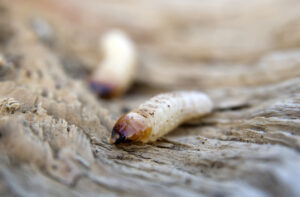
Need Help? Call Us On 0161 776 9832 For Expert Pest Control Advice On How To Identify Pest Infestations And Help Solve Your Pest Problem.
Leigh Woodworm Treatment Options
The Most Common Woodworm Types in the UK
 At Young’s Pest Control, our Leigh woodworm treatment spray service is very popular because of the untold damage woodworm cause. A woodworm infestation means damage to furniture, flooring, or structural timbers. It is important that you know the common woodworm types in the UK since early detection will help you hire a professional in good time before the problem exacerbates. Note that ‘woodworm’ refers to the larvae of wood-boring beetles.
At Young’s Pest Control, our Leigh woodworm treatment spray service is very popular because of the untold damage woodworm cause. A woodworm infestation means damage to furniture, flooring, or structural timbers. It is important that you know the common woodworm types in the UK since early detection will help you hire a professional in good time before the problem exacerbates. Note that ‘woodworm’ refers to the larvae of wood-boring beetles.
Common Furniture Woodworm Beetle
Anobium punctatum is the most common woodworm beetle in the UK. The beetle can reach lengths of up to 4.5 millimetres. It is brown in colour and its pronotum looks like the cowl of a monk.
You should do woodworm removal the moment you notice this beetle because it leaves exit holes that are 1 to 2 millimetres in diameter on softwood timber species. The beetle prefers damp areas. You should also do treatment for woodworm removal if you have plywood anywhere in your home because the woodworm bores into, and stays in plywood. Also susceptible are:
• Homes that have damp floorboards
• Old furniture where the polished finish is worn off
• Wooden tools
• Musical instruments
• Damp loft timber
The larvae live for 3 to 5 years boring through your timber before they emerge to mate.
Death Watch Woodworm Beetle
The death watch beetle (Xestobium rufovillosum) is a British native that has been around for hundreds of years. An adult death watch beetle grows to between 5 and 7 millimetres in length and has a dark reddish brown coat.
Most susceptible to attacks by its larvae are hardwoods like seasoned oak, sweet chestnut, and ash, particularly those that are softened by fungal decay. This means you should seriously consider Leigh woodworm treatment spray if you have an old building. Regular treatment for woodworm is important because the larva will tunnel your timber for between 5 and 10 years before they emerge. You should also get rid of the pest because they make annoying ‘ticking’ and ‘tapping’ noise when they are attracting mates.
House Longhorn Woodworm Beetle
 The house longhorn beetle (Hylotrupes bajulus) is not native to the UK, but it now has a global distribution. It grows to between 8 and 25 millimetres in length. The beetles are brown/black in colour with greyish hair and two black spots on the thorax.
The house longhorn beetle (Hylotrupes bajulus) is not native to the UK, but it now has a global distribution. It grows to between 8 and 25 millimetres in length. The beetles are brown/black in colour with greyish hair and two black spots on the thorax.
The beetles usually infest partly seasoned and seasoned softwoods like spruce, fire, and pine. You should be on the lookout for the woodworm in the chimney area and in the roof space. These beetles cause the greatest damage of all beetles because they make flight holes of between 3 and 7 millimetres. We recommend a Leigh woodworm treatment spray even when you do not see signs of the woodworm on your because the larvae tunnel for between 3 and 11 years before they emerge to mate.
Powder Post Woodworm Beetle
The powder post beetle (Lyctus brunneus) is a reddish-brown beetle that grows to between 4 and 7 millimetres in length. It infests such hardwoods as ash, oak, elm, sycamore, African mahogany, sweet chestnut, and walnut.
The beetles usually make exit holes of between 1 and 2 millimetres (commonly referred to as shot holes). Note that these are the primary pests in timber yards. The larvae reduce infested timber, leaving a thin wood veneer on the surface.
